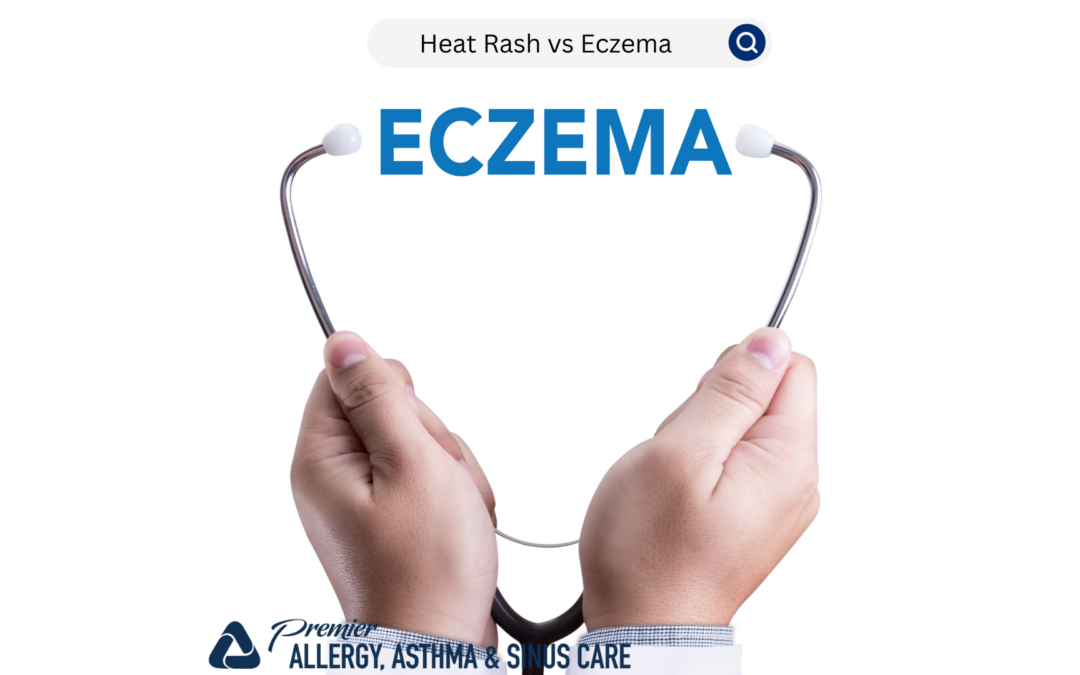At Premier Allergy, Asthma & Sinus Care, we often encounter patients who are confused about the differences between heat rash and eczema. Both conditions can cause discomfort and irritation, but understanding their distinct characteristics, causes, and treatments can help manage them more effectively. This guide will delve into the similarities and differences between heat rash and eczema, helping you identify and treat each condition properly.
What is Heat Rash?
Heat rash, also known as prickly heat or miliaria, occurs when sweat ducts become blocked, trapping sweat beneath the skin. This condition is common in hot, humid environments and can affect people of all ages, but it’s especially prevalent in infants.
Symptoms of Heat Rash:
-
Small, red bumps or blisters
-
Itching or a prickly sensation
-
Mild swelling
Heat rash typically appears on areas of the body that are prone to sweating, such as the neck, chest, back, and skin folds.
Causes of Heat Rash:
-
Hot and humid weather
-
Prolonged physical activity
-
Overdressing or wearing tight clothing
-
Poorly ventilated areas
What is Eczema?
Eczema, or atopic dermatitis, is a chronic skin condition characterized by inflammation, itching, and redness. It is often associated with a genetic predisposition and can be triggered by various environmental factors. Unlike heat rash, eczema is a long-term condition that can flare up periodically.
Symptoms of Eczema:
-
Red or brownish-gray patches
-
Severe itching, especially at night
-
Dry, scaly, or thickened skin
-
Small, raised bumps that may leak fluid when scratched
Eczema commonly appears on the face, neck, elbows, knees, and wrists, but it can affect any part of the body.
Causes of Eczema:
-
Genetic factors
-
Immune system dysfunction
-
Environmental triggers (e.g., allergens, irritants, stress)
-
Climate changes (e.g., hot and humid or cold and dry weather)
Key Differences Between Heat Rash and Eczema
While heat rash and eczema can appear similar, several key differences can help distinguish between the two:
1. Onset and Duration:
-
Heat Rash: Appears suddenly and is typically short-lived, resolving once the skin cools down and sweating is reduced.
-
Eczema: Chronic condition with periods of flare-ups and remissions, often lasting for months or years.
2. Location:
-
Heat Rash: Common in areas prone to sweating, such as the neck, chest, and skin folds.
-
Eczema: Can appear anywhere on the body, but commonly affects the face, neck, elbows, knees, and wrists.
3. Appearance:
-
Heat Rash: Characterized by small, red bumps or blisters.
-
Eczema: Manifests as red or brownish-gray patches, dry and scaly skin, and intense itching.
4. Causes:
-
Heat Rash: Caused by blocked sweat ducts and excessive sweating.
-
Eczema: Linked to genetic factors, immune system dysfunction, and environmental triggers.
Diagnosis and Treatment
Proper diagnosis and treatment are essential for managing both heat rash and eczema effectively. Here’s how each condition can be diagnosed and treated:
Diagnosing Heat Rash:
-
Physical Examination: A healthcare provider can typically diagnose heat rash based on a physical examination and the patient’s history of exposure to hot and humid conditions.
-
Symptom Assessment: Evaluating the appearance and location of the rash helps confirm the diagnosis.
Treating Heat Rash:
- Cool the Skin: Move to a cooler environment and use fans or air conditioning to reduce sweating.
- Wear Loose Clothing: Opt for lightweight, breathable fabrics like cotton to prevent further irritation.
- Keep the Skin Dry: Use talcum powder to absorb excess moisture and prevent sweat buildup.
- Avoid Heavy Creams: Stick to light, water-based lotions if needed.
Diagnosing Eczema:
-
Medical History: A detailed medical history, including family history of allergies or asthma, can help diagnose eczema.
-
Physical Examination: A healthcare provider will examine the affected skin areas and assess the severity and distribution of the rash.
-
Allergy Testing: In some cases, allergy testing may be performed to identify potential triggers.
Treating Eczema:
- Moisturize Regularly: Use thick, fragrance-free moisturizers to keep the skin hydrated and reduce itching.
- Avoid Triggers: Identify and avoid allergens, irritants, and stressors that can trigger flare-ups.
- Medications: Topical corticosteroids, calcineurin inhibitors, and antihistamines may be prescribed to manage symptoms and reduce inflammation.
- Wet Wrap Therapy: For severe cases, wet wrap therapy can help soothe and hydrate the skin.
- Light Therapy: Phototherapy, or light therapy, may be recommended for individuals with moderate to severe eczema.
Preventing Heat Rash and Eczema Flare-Ups
While it may not be possible to completely prevent heat rash or eczema, certain strategies can help minimize the risk and severity of flare-ups:
Preventing Heat Rash:
-
Stay Cool: Avoid excessive heat and humidity by staying in air-conditioned environments during hot weather.
-
Dress Appropriately: Wear loose, lightweight clothing made of breathable fabrics.
-
Stay Dry: Keep the skin dry and avoid prolonged periods of sweating.
-
Take Breaks: If engaging in physical activity, take frequent breaks to cool down and dry off.
Preventing Eczema Flare-Ups:
-
Moisturize Daily: Regularly apply moisturizers to maintain the skin’s barrier function.
-
Identify and Avoid Triggers: Keep a diary to track potential triggers and avoid known allergens and irritants.
-
Manage Stress: Practice stress-reducing techniques such as yoga, meditation, or deep breathing exercises.
-
Use Gentle Products: Choose hypoallergenic and fragrance-free skin care products to reduce the risk of irritation.
-
Maintain a Healthy Diet: Eat a balanced diet rich in anti-inflammatory foods to support overall skin health.
When to See a Doctor
If you or your child experience symptoms of heat rash or eczema that do not improve with home care, it’s important to seek medical advice. Consult a healthcare provider if:
-
The rash becomes infected (e.g., increased redness, swelling, pus, or fever).
-
Symptoms are severe or worsen over time.
-
Over-the-counter treatments are not effective.
-
There is uncertainty about the diagnosis.
Understanding the differences between heat rash and eczema is crucial for effective management and treatment. While both conditions can cause discomfort, they have distinct causes, symptoms, and treatments. By recognizing these differences and taking proactive steps, you can help manage symptoms and improve your skin’s health. If you’re ever in doubt, reach out to us today to schedule an appointment. We’re here for you.





